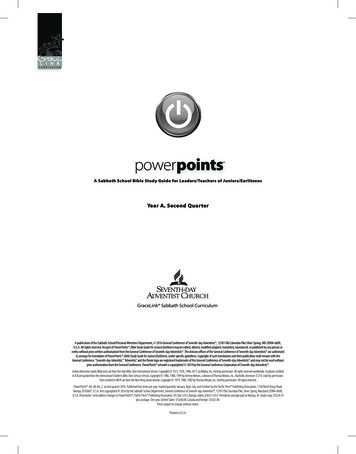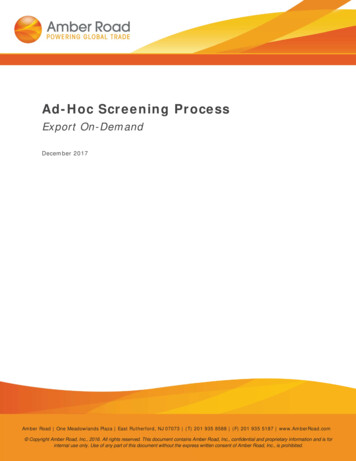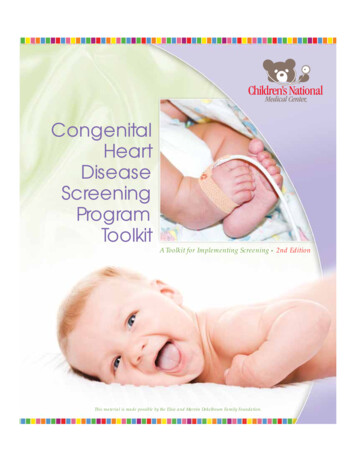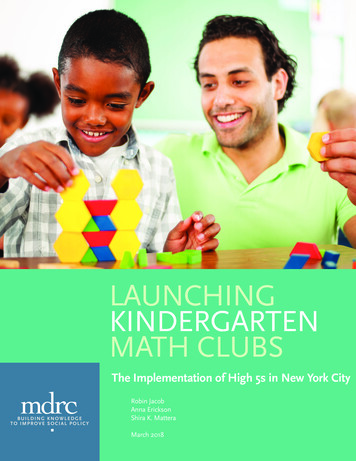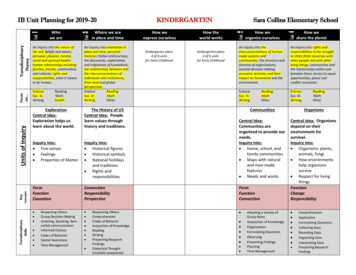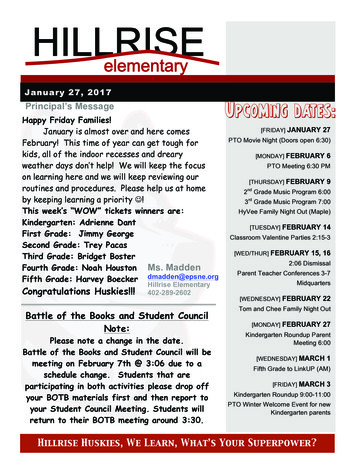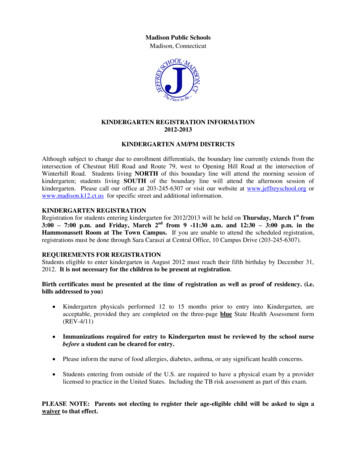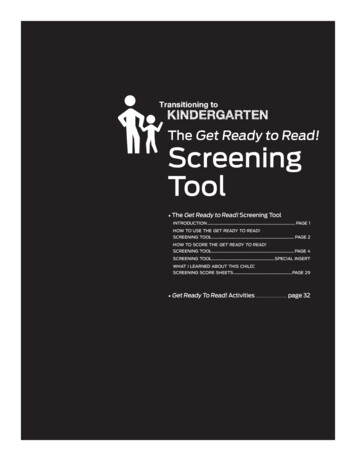
Transcription
The Get Ready to Read!ScreeningTool The Get Ready to Read! Screening Toolintroduction. page 1how to use the get ready to read!screening tool. page 2how to score the get ready to read!screening tool. page 4screening tool.special insertwhat i learned about this child:screening score sheets.page 29 Get Ready To Read! Activities. page 32
The National Center for Learning Disabilities (NCLD) improves the lives of all peoplewith learning difficulties and disabilities by empowering parents, enabling young adults,transforming schools, and creating policy and advocacy impact.www.ncld.orgRandi WeingartenpresidentLorretta Johnsonsecretary-treasurerFrancine Lawrenceexecutive vice presidentOUR MISSIONThe American Federation of Teachers is a union of professionals that champions fairness;democracy; economic opportunity; and high-quality public education, healthcare and publicservices for our students, their families and our communities. We are committed to advancingthese principles through community engagement, organizing, collective bargaining andpolitical activism, and especially through the work our members do.www.aft.orgGet Ready to Read! Screening Tool Copyright 2002 Pearson Education, Inc. publishing as Pearson Early Learning.Reproduced with permission. All rights reserved.“Get Ready to Read!” is a trademark, in the US and/or other countries, of Pearson Education, Inc. or its affiliates(s).Copyright 2006 National Center for Learning Disabilities, Inc. All rights reserved.
The Get Ready to Read!Screening ToolThe Get Ready to Read! Screening Tool is a 20-itemearly literacy screening tool for young children inthe year before kindergarten. It was developed inconjunction with the National Center for LearningDisabilities by some of the country’s top readingresearchers.The Get Ready to Read! Screening Tool takes about10 minutes to administer and was designed toprovide early childhood professionals and parentswith a “snapshot” of where a child is on the pathto developing important early literacy skills. TheScreening Tool is NOT a formal assessment or away to identify disabilities. However, it can give youimportant information about a child’s skills that canhelp inform what you do in the classroom.The Get Ready to Read! Screening Tool is typicallyadministered in the fall of the year before a childstarts kindergarten, again in the spring beforekindergarten starts, and occasionally one additionaltime in between. However, you can get usefulinformation about a child’s skills anytime during theyear before kindergarten and use that informationto help inform classroom and home activities. Theskill-building activities included in this section are agood starting point. There are also special activitycards for parents to use with their children in theparent section of this toolkit. For an online versionof the Screening Tool as well as additionalresources please visit the Get Ready to Read!website at www.getreadytoread.org.This section includes a guide to using the Get Readyto Read! Screening Tool with the children in yourcare and also a guide to scoring and interpretingthe Screening Tool.The items on the Get Ready to Read! Screening Toolare based on skills that many years of research haveshown to be especially important for a young childto be ready to learn to read.These skills include:Print knowledgePrint knowledge: a child’s understandingof books, printed letters, and words. Skillsinclude: Differentiating print from pictures Functions of print Book rules Print components Rules of print Naming lettersLinguistic awarenessLinguistic awareness: a child’s understanding of how words and language works.Skills include: Active listening Vocabulary Rhyming words Segmenting sentences Segmenting words Phonemic awarenessEmergent writingEmergent writing: a child’s first efforts tocreate and use print in a meaningful way.Skills include: Scribbling Drawing Copying Printing letters Printing name Invented spellingTHE GET READY TO READ! SCREENING TOOL / 1
Screening ToolGet Ready to Read!how to use the screening tool1. Look through the screening tool.It helps to read through the screening tool right before you begin screeningthe children to familiarize yourself with the tool.2. Find a quiet place to work with one child at a time.Find a place where you will be able to sit next to, not across from, the child ata table, on a couch or on the floor. It helps to have a flat surface like a smalltable in front of you on which you can show the screening items. The childdoes not have to be removed from the classroom or home setting. You canuse a quiet corner where there won’t be a lot of distractions. You will needabout 10 minutes to complete the screening with a child.3. Plan ahead to make the screening process run smoothly.If you are in a classroom, family child care home or other group setting, youmay want to tell the children who will be screened that they are all goingto have a chance to do this special activity. Select an easy going, interestedchild to screen first or ask for volunteers. Be encouraging. Approach thechild individually and take him or her to the screening area.4. Prepare the screening area and gather the materialsthat you will need:The screening tool, a separate answer sheet labeled with the child’s name,and a pencil or pen.5. Complete the information about the child at the top ofthe answer sheet.Be sure that you also fill in the date and which screening this will be forthe child (e.g., first, second).6. Place the screening booklet directly in front of the child.The child should have a straight and direct view of the screening tool items.Be sure to only show the child one page at a time, by folding the bookletback, as you administer the 20 items of the screening tool.2 / TRANSITIONING TO KINDERGARTEN
Screening ToolGet Ready to Read!how to use the screening tool7. Start with the sample item.The purpose of the sample item is to make sure that the child understandswhat to do. When you are ready to begin the screening with a child, you willopen the booklet and fold the page back to show just the sample item. Placethe booklet directly in front of the child and put the copy of the answer sheetin front of you. First, introduce the activity to the child:Let’s look at some pictures. [Point to the pictures in the sample item.] I will askyou a question about them and you put your finger on the picture that is thebest answer to the question. Let’s try one.Then, read aloud the sample item using the exact words that are in thescreening tool.8. On the sample item you may give hints and feedback to make surethat the child understands the instructions.You may not do this on the 20 items in the tool. Give the child general praiseafter he or she completes the sample item. Say something like this:You’ve got the idea! Now I am going to ask you some more questions. Eachtime I ask a question, you choose the picture that is the best answer. Just lookcarefully at the pictures and pick the one you think is right.Once the child has selected an answer on each item, mark the child’s choicedirectly on the answer sheet by circling the answer that the child has chosen.9. Then, proceed with the 20 items of the screening tool, one by one,in the order in which they appear in the manual.Ask each question exactly how it is worded in the screening tool. Be sure toshow the child just one item at a time by folding the page back. Circle theanswer that the child has chosen for each item as soon as the child selects it.Do not worry at this time about checking to see if it is the correct answer.THE GET READY TO READ! SCREENING TOOL / 3
Screening ToolGet Ready to Read!how to score the screening tool1. As you are administering the tool, circle the child’s answerfor each item.You should NOT decide whether the answer is correct or incorrect at thispoint because you will want to move on to the next question.2. When you are ready to score a child’s answer sheet, you will needBOTH the answer sheet that you used with the child and the answersheet with the correct answers shaded to use as an “answer key.”This “answer key” can be found at tinyurl.com/grtr-key.3. Place the answer sheet and the “answer key” from the manualside by side on the table in front of you.4. Begin with Item 1—remember not to score the Item Sample!For each question, compare the child’s answer with the answer that is shaded on the “answer key.” If the child’s answer is correct, place a “1” in thelower right corner of that box. If the child’s answer is not correct, place a “0”(zero) in the lower right corner of that box.5. Count the number of correct answers by counting onlythe “1’s” that you wrote.Remember do not count the sample!6. Count the answers again to double-check your counting.7. When you are sure of the score, write the total number ofcorrect answers in the box at the bottom of the page.4 / TRANSITIONING TO KINDERGARTEN
Get Ready to Read! Screening Tool. Copyright 2002 Pearson Education, Inc. publishing asPearson Early Learning. Reproduced with permission. All rights reserved.“Get Ready to Read!” is a trademark, in the US and/or other countries, of Pearson Education, Inc.or its affiliates (s).
Screening ToolGet Ready to Read!what i learned about this childChild’s Name Date of Birth / /Get Ready to Read! Screening #1Date:Total number correct: out of 20General Observations:Follow-Up ActivitiesPrint Knowledge Skills (books, printed letters and words):Emergent Writing Skills (first efforts to create and use print in a meaningful way):Linguistic Awareness (first efforts to create and use print in a meaningful way):Some activities that really worked with this child:Something different I could try with this child:THE GET READY TO READ! SCREENING TOOL / 29
Screening ToolGet Ready to Read!what i learned about this childChild’s Name Date of Birth / /Get Ready to Read! Screening #2Date:Total number correct: out of 20General Observations:Follow-Up ActivitiesPrint Knowledge Skills (books, printed letters and words):Emergent Writing Skills (first efforts to create and use print in a meaningful way):Linguistic Awareness (first efforts to create and use print in a meaningful way):Some activities that really worked with this child:Something different I could try with this child:30 / TRANSITIONING TO KINDERGARTEN
Screening ToolGet Ready to Read!what i learned about this childChild’s Name Date of Birth / /Get Ready to Read! Screening #3Date:Total number correct: out of 20General Observations:Follow-Up ActivitiesPrint Knowledge Skills (books, printed letters and words):Emergent Writing Skills (first efforts to create and use print in a meaningful way):Linguistic Awareness (first efforts to create and use print in a meaningful way):Some activities that really worked with this child:Something different I could try with this child:THE GET READY TO READ! SCREENING TOOL / 31
Screening ToolGet Ready to Read!activitiesThe following pages contain the Get Ready to Read! skill-building activities. Theseactivities are engaging, child-friendly early literacy activities for preschoolers.You can use the child’s score on the screening tool to help you decide whether tostart with “beginning” activities, “making progress” activities, or “ready to read”activities, or you can just use your knowledge of the child’s skills.The activities are organized by skill domain and level. Each activity also stateswhich specific skill the activity addresses. For more information about the skilldomains, please see the information about the Get Ready to Read! Screening Toolat the beginning of this section. Here is what you will find:“BEGINNING” ACTIVITIESABCLearningAbout Print(PRINT KNOWLEDGE) Making a Menu My Favorite Book My Name Has Letters The Reading Puppet“BEGINNING” ACTIVITIES Draw to the Music Draw Your DayBeginning I Can Write Letters! Tell Me AboutWriting(EMERGENT WRITING)Your Picture Walk on a Letter“BEGINNING” ACTIVITIESOral Skills:Talking AndListening Be an Expert Listener Find the Rhymes How Many Words? Match That Sound(LINGUISTICAWARENESS)32 / TRANSITIONING TO KINDERGARTEN“MAKING PROGRESS” ACTIVITIES Find a Word Fishing for Letters Name Memory Word Puzzles“MAKING PROGRESS” ACTIVITIES Build Your Name Clay Letters Copy a Card Sequence Story Trace Your Name“MAKING PROGRESS” ACTIVITIES Be a Word Find the CompoundWords Jump for a Rhyme Mystery Sound Rhyme-Out“READY TO READ” ACTIVITIES Letter Memory My Word Box Pick a Letter Word Jump“READY TO READ” ACTIVITIES Guess What’s Inside Send a Message“READY TO READ” ACTIVITIES First Sound Sort Stretched-out Story What Word is Left?
Screening ToolGet Ready to Read!activitiesLearning About Print: BeginningABCMaking a MenuGet Ready to Read!SMWhat You Need: paper glue stick pictures of food cut out from magazines crayons or markers names of different foods clearly written on index cardsWhat You Do:1. Discuss with the children the purpose and use of a menu.2. Choose a meal for the children to make menus.3. Lay out the pictures of food.4. Have the child or children pick out a few pictures. Discuss good choices and favorites.5. Write "MENU" at the top of each page. Help children who are ready write the word ontheir own.6. Have the children glue the pictures of the selected foods down the left side of the paper.7. Help children find the names of the selected foods. They can either glue the name next tothe food or copy it directly onto the paper.8. Ask each child to read the menu back to you or share it with a friend.Why?Children become familiar with one of the many functions of print. 2005 by National Center for Learning Disabilities, Inc.www.getreadytoread.orgTHE GET READY TO READ! SCREENING TOOL / 33
Screening ToolGet Ready to Read!activitiesLearning About Print: BeginningABCMy Favorite BookGet Ready to Read!SMWhat You Need: construction paper pictures cut from magazines and newspapers markers stapler glueWhat You Do:1. Fold two sheets of construction paper and staple them along the crease to make a book.2. Have the child pick a title for the book, such as "My Favorite Toys," "My Favorite Animals"or "My Favorite Foods." Write the title and the child's name on the front of the book.3. Have the child pick pictures that have to do with the chosen title and glue them intothe book.4. Encourage the children to share their books with each other.Why?Children learn that pictures and print carry messages and have many uses. Children alsolearn how books work. 2005 by National Center for Learning Disabilities, Inc.34 / TRANSITIONING TO KINDERGARTENwww.getreadytoread.org
Screening ToolGet Ready to Read!activitiesLearning About Print: BeginningABCMy Name Has LettersGet Ready to Read!SMWhat You Need: plastic 3-D letter paper markers shallow basketWhat You Do:1. Using the plastic letters, spell the child's name on the paper.2. Trace the letters with the marker so that the child's name is written on the paper. Color inthe letters all the same color.3. Place the plastic letters that are in the child's name in the shallow basket.4. Have the child pick letters from the basket and match them, one by one, to thecorresponding letters on the paper. Continue until the child's name is spelled.Why?The child learns that his or her name is made up of letters and what those letters look like. 2005 by National Center for Learning Disabilities, Inc.www.getreadytoread.orgTHE GET READY TO READ! SCREENING TOOL / 35
Screening ToolGet Ready to Read!activitiesLearning About Print: BeginningABCThe Reading PuppetGet Ready to Read!SMWhat You Need: puppet or stuffed animal big book on standWhat You Do:1. Place the book upside-down on the stand.2. Bring out the puppet and introduce it to the children. Explain that the puppet is going toread the book, but will need some help. Encourage the children to interact with the puppet.3. Begin the activity by having the puppet look for the title, author and illustrator of thebook. Since the book is upside-down, the puppet should ask for help from the children. Forexample, “I want to read this book, but first I need to tell you the title. I can’t find it! Thebook is upside down. There’s the title. What does ‘title’ mean?”4. Continue the activity with the puppet asking for the children’s help reading the book. Forexample. “What should I do first if I want to read the book?” “Where should I start reading?”“Help me turn the page.” “Can you help me find the picture of ?”Why?Children become aware of book rules. 2005 by National Center for Learning Disabilities, Inc.36 / TRANSITIONING TO KINDERGARTENwww.getreadytoread.org
Screening ToolGet Ready to Read!activitiesLearning About Print: Making ProgressABCFind a WordGet Ready to Read!SMWhat You Need: pictures of familiar items cut from magazines and advertisements(Some pictures should include print, and some should be simply a picture without any print.) scissors glue index cardsWhat You Do:1. In advance, glue each picture onto an index card.2. Give each child two cards, one that has a word or words on it and one that is just a picture.3. Say, "Letters can go together to make words. Look for letters and words on your cards.Hold up your card that has a word on it."4. Choose a child to bring his or her card to you and place it where it can be seen by all thechildren. Challenge the children to tell you what word they see in the picture.5. Repeat with a few cards. Reinforce the purpose of the print in each picture. For example, say,"This cereal box has a word on it that tells us the cereal's name."Why?Children learn to differentiate print from pictures and learn one of the purposes of print. 2005 by National Center for Learning Disabilities, Inc.www.getreadytoread.orgTHE GET READY TO READ! SCREENING TOOL / 37
Screening ToolGet Ready to Read!activitiesLearning About Print: Making ProgressABCFishing for LettersGet Ready to Read!SMWhat You Need: construction paper strings scissors large paper clips marker magnet stick or wooden dowelWhat You Do:1. Cut out 26 fish shapes from the construction paper.2. Have children decorate one side of each fish.3. On the other side of each fish, write a letter of the alphabet.4. Slide a paper clip onto each fish's tail.5. To make the "fishing rod," tie the string to the end of the dowel or stick. Tie the magnet tothe other end of the string.6. Scatter the fish on the floor with the letter side down.7. Have the children try to "catch" a fish with the fishing rod and say the name of the letter onthat fish.8. For a more advanced version of the game, children can also say the letter's sound or a wordthat starts with that sound.Why?Children become aware of letter shapes, names and sounds. 2005 by National Center for Learning Disabilities, Inc.38 / TRANSITIONING TO KINDERGARTENwww.getreadytoread.org
Screening ToolGet Ready to Read!activitiesLearning About Print: Making ProgressABCName MemoryGet Ready to Read!SMWhat You Need: same-colored index cards markersWhat You Do:1. Make the game cards: Using only the letters in the child’s name, write each letter on twocards so that you have several pairs of cards.2. Shuffle the cards and spread them out face down.3. Ask the child to turn over any two cards. If the cards match, help the child name the letter.The child then keeps the cards. If the cards do not match, the child turns the cards back overand tries again.4. Play continues until all matches have been made.5. Help the child put the letters in order to spell his or her name.Why?The child will become familiar with the names and shapes of the letters in his or her name. 2005 by National Center for Learning Disabilities, Inc.www.getreadytoread.orgTHE GET READY TO READ! SCREENING TOOL / 39
Screening ToolGet Ready to Read!activitiesLearning About Print: Making ProgressABCWord PuzzlesGet Ready to Read!SMWhat You Need: several empty cartons of foods familiar to your child (e.g., cereals, milk, pasta) plastic sandwich bagsWhat You Do:1. Cut the carton front into 4-5 puzzle-shaped pieces.2. Place each puzzle into a bag. If possible, have an intact, identical carton front for the childrento see as a model.3. Have the children put the puzzle together. Ask them to point out the food words on thepuzzle and say them out loud.Why?Children become aware of print in our everyday world and learn to differentiate printfrom pictures. 2005 by National Center for Learning Disabilities, Inc.40 / TRANSITIONING TO KINDERGARTENwww.getreadytoread.org
Screening ToolGet Ready to Read!activitiesLearning About Print: Ready to ReadABCLetter MemoryGet Ready to Read!SMWhat You Need: same-colored index cards markersWhat You Do:1. Make the game cards: Choose 6 letters that the children have been learning or need topractice. Write each letter on two cards so that you have 6 pairs of cards.2. Shuffle the cards and place them face down.3. Ask a child to turn over two cards. If the cards match, the child names the letter and keepsthe cards. If the cards do not match, the child turns the cards back over and tries again.4. Play continues until all matches have been made.Why?Children becomes familiar with the names and shapes of the letters of the alphabet. 2005 by National Center for Learning Disabilities, Inc.www.getreadytoread.orgTHE GET READY TO READ! SCREENING TOOL / 41
Screening ToolGet Ready to Read!activitiesLearning About Print: Ready to ReadABCMy Word BoxGet Ready to Read!SMWhat You Need: small box index cards magnet markerWhat You Do:1. Label each box with a child's name2. Have each child decorate his or her box.3. Ask children to tell you 3 or 4 of their favorite words or wordsthat are important to them.4. Write these words on index cards and have the children keep the special words in his or herown box. Repeat steps 3 and 4 every few days.5. Children can include pictures on the cards that illustrate some of the words.6. Every few days, ask children to “read” their cards to you and tell you about the words.Why?Children begin to recognize words that are important to them. 2005 by National Center for Learning Disabilities, Inc.42 / TRANSITIONING TO KINDERGARTENwww.getreadytoread.org
Screening ToolGet Ready to Read!activitiesLearning About Print: Ready to ReadABCPick a LetterGet Ready to Read!SMWhat You Need: brown paper bags plastic lettersWhat You Do:1. Place 10 letters in the bags.2. Model the activity by closing your eyes and picking a letter. As you feel the letter,describe what letter you think you’ve picked. Open your eyes and confirm your answerwith the children.3. Have a child close his or her eyes and pick out a letter.4. Ask the child, “What letter do you think it is?” If the child is having troubleidentifying the letter, give clues.VariationHide the letters in a bin of sand or rice. Have the child match the letter that he or she finds towords you have printed on a piece of paper.Why?Children learn about letter shapes and letter names. 2005 by National Center for Learning Disabilities, Inc.www.getreadytoread.orgTHE GET READY TO READ! SCREENING TOOL / 43
Screening ToolGet Ready to Read!activitiesLearning About Print: Ready to ReadABCWord JumpGet Ready to Read!SMWhat You Need: large index cards (or paper) marker list of simple words (see list below)What You Do:1. Choose eight words that the children are learning.2. Write each word in large print in lowercase letters on an index card.3. Spread the words out on the floor.4. Say a word, and ask a child to jump to that word and read it.5. Have other children take turns jumping to words that you say.Why?Children will begin to recognize simple words.Sample Simple Words:And, the, in, is, on, you, cat, it, my, we, me, with 2005 by National Center for Learning Disabilities, Inc.44 / TRANSITIONING TO KINDERGARTENwww.getreadytoread.org
Screening ToolGet Ready to Read!activitiesBeginning Writing: BeginningDraw to the MusicGet Ready to Read!SMWhat You Need: music with different styles and tempos paper crayonsWhat You Do:1. Give each child paper and crayons. You can use construction paper for individual children,or mural paper on the wall or floor for a whole group.2. Tell the children to draw when the music is on and stop drawing when the music is off.3. Turn on the music.4. Let the children draw for a few minutes. Turn the music off and remind the children tostop drawing.5. Repeat several times, changing the music after a few minutes to a different style or tempo.Why?Children learn to connect their motor actions with the marks they make on the paper. They alsogain practice controlling a crayon. 2005 by National Center for Learning Disabilities, Inc.www.getreadytoread.orgTHE GET READY TO READ! SCREENING TOOL / 45
Screening ToolGet Ready to Read!activitiesBeginning Writing: BeginningDraw Your DayGet Ready to Read!SMWhat You Need: a variety of drawing materials (crayons, markers, pencils) paperWhat You Do:1. As the children watch you, write at the top of the paper, “Today in school, I will . “ or“Today at home, we will . “2. Ask the children to finish the sentence with a drawing of something that will happenthat day in school or at home.Why?Children learn that they can draw a picture can tell a story or describe an event. 2005 by National Center for Learning Disabilities, Inc.46 / TRANSITIONING TO KINDERGARTENwww.getreadytoread.org
Screening ToolGet Ready to Read!activitiesBeginning Writing: BeginningI Can Write Letters!Get Ready to Read!SMWhat You Need: sandpaper baking sheet with sand spread out on it large squares of carpetWhat You Do:1. Have the children stand up.2. With your back to them, "write" the letter that you are teaching them in the air in front ofyou with your index finger. This should be done in a large and exaggerated way. Make surethat the children can see what you are doing. Say the name of the letter as you "write" it inthe air. Do this several times along with the children.3. Children should then be encouraged to experiment with "writing" the letter with their indexfingers on sandpaper, in sand on a baking sheet and on carpet. Make sure to observe thechildren's attempts and help them as necessary.Why?Children develop sensitivity to the muscle movements involved in writing letter shapes, whichwill help them to learn how letters are formed. 2005 by National Center for Learning Disabilities, Inc.47 / TRANSITIONING TO KINDERGARTENwww.getreadytoread.orgTHE GET READY TO READ! SCREENING TOOL / 47
Screening ToolGet Ready to Read!activitiesBeginning Writing: BeginningTell Me About Your PictureGet Ready to Read!SMWhat You Need: drawing paper crayons black markerWhat You Do:1. Give the children drawing paper and crayons. Tell them to draw a picture of an activity thatthey have done recently. For example, they can draw about something they did in school orat home.2. Ask each child, one at a time, to describe to you what they have drawn. Write, in clearprint with the black marker, what each child says on his or her picture, and then read itback to the child.Why?Children learn that pictures and words can be used to describe experiences in their lives. 2005 by National Center for Learning Disabilities, Inc.48 / TRANSITIONING TO KINDERGARTENwww.getreadytoread.org
Screening ToolGet Ready to Read!activitiesBeginning Writing: BeginningWalk on a LetterGet Ready to Read!SMWhat You Need: masking tapeWhat You Do:1. Make a large letter on the floor with the masking tape.2. Tell the children the name of the letter and a word that begins with that letter.3. Have the children walk or jump on the masking tape in the shape of the letter. They can saythe name of the letter as they do it.4. Tell the children a few other words that start with the letter. Ask them if they can thinkof more.Why?Children become familiar with the names and shapes of the letters of the alphabet. 2005 by National Center for Learning Disabilities, Inc.www.getreadytoread.orgTHE GET READY TO READ! SCREENING TOOL / 49
Screening ToolGet Ready to Read!activitiesBeginning Writing: Making ProgressBuild Your NameGet Ready to Read!SMWhat You Need: uppercase and lowercase plastic letters bag or cloth sack paper pencil or crayonsWhat You Do:1. Write a child's name at the top of the paper in large letters, using an uppercase letter for thefirst letter in the child's name, followed by lowercase letters.2. Place the plastic letters that are in the child's name into the bag. Also include one or twoletters that are not part of the child's name.3. Tell the child to pick a letter out of the bag.4. Ask the child, "What is the name of the letter that you picked? Look at your name. Is thisletter in your name?"5. Ask the child to place the plastic letter under the written letter, and continue until the childhas picked all of the letters in his or her name.6. When the child's name is complete, ask the child to print it out on the paper.Why?Children become familiar with the letters in their name. 2005 by National Center for Learning Disabilities, Inc.50 / TRANSITIONING TO KINDERGARTENwww.getreadytoread.org
Screening ToolGet Ready to Read!activitiesBeginning Writing: Making ProgressClay LettersGet Ready to Read!SMWhat You Need: modeling clay or play-dough paper and pencilWhat You Do:1. Print a few letters of the alphabet on the paper, making them at least 6 inches tall.2. Roll lumps of clay or dough into long, thin strips.3. Help
of books, printed letters, and words. Skills include: Differentiating print from pictures Functions of print Book rules Print components Rules of print Naming letters Linguistic awareness Linguistic awareness: a child's understand-ing of how words and language works. Skills include: Active listening Vocabulary .

